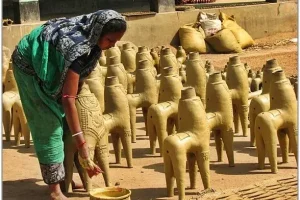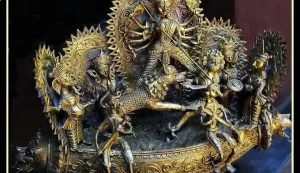The Masked Expressions
The cultural heritage of a State, is preserved, among many things, through its folk traditions. Chhau, a mask dance, performed in certain areas of West Bengal, has a distinctive character of its own. Although this dance is part of the folk cultures of Bihar and Orissa as well, the Bengal Chhau, which has received international acclaim in recent years, has scaled a rare height of beauty and perfection. The approved theme of West Bengal Tableaux in this year`s (1995) Republic Day Function at New Delhi is the vigorous Chhau Dance (Masked Dance).
Essentially a festival dance, Chhau was originally performed on the occasion of the sun Festival towards the end of the month of Chaitra (March-April) in Bengali Calendar. The festival continued for about one-and-a-half months till before the sowing season which indicates it was interlinked with the social and economic life of the Bengal farmer. The situation has changed with the passing of time, as Chhau is new performed during some other festivals at other times of year as well. The rural artistes of Midnapur (mainly concentrated in Jharqram Sub-division area), and Purulia districts, who have kept alive this tradition against heavy odds, have given the dance its own identity, thereby making it distinctively different from the Chhau that is performed in parts of Serai KelIa of Bihar and Mayurbnanj of Orissa.
The Charms of Chhau
The Chhau dance is epical in content, as it is based on various episodes of the Ramayana. And the Mahabharata. Sometimes certain episodes of the Puranas are also used. The dominant rasas are Vira and Rudra. In the end, generally, forces of evil are vanquished and the righteous triumphs. No dais or raised platform, is used; the dance, takes place on the ground around which, the spectators sit in a circle. A nocturnal dance., the Chhau shows usually start around 10 in the night and continue till after daybreak.
The use of the drum is an important part of Chhau. The dance, opens with the beating of drums followed by an invocation to God Ganesha. by a singer. As soon as the singer finishes the song, host of drummers and musicians step in again with the dhol and the dhamsa (indigenously made two faced percussion instrument and gigantic kettle drum played with sticks and fingers respectively) two traditional musical instruments used by the rural population in various parts of the country. The drummers usually hail from the Kalindi and Machuar community who are economically backward and by age-old practice and tradition of Chhau dance, the drummers themselves make and tune the dhol and the dhamsa. Along with the team of drummers the musical part, which is an integral prelude to the actual dance, is also vastly enriched by one or two musicians who play on an instrument which is a unique improvisation of Sheh-nai, a variant of the flute. The animated, stuporous performance of the musician team is really seen to be believed and acts as an inspiring tonic to the actual dancers to bring out the best in them. In fact the team of musicians by music and chanting of bols- (Beats) creates an in inexplicably wonderful environ prior to the dance. This is the time for the Lord Ganesha to appear on the dancing ground. He is followed in quick succession by other characters —gods, demons, animals and birds.
Magical Experience :
The Performers of The Magic
It is not easy to guess what costumes the Chhau, performers used when this particular dance-form came into Being over two hundred years ago. The costumes used now are of various colours and designs pyjamas of deep green or yellow or red shade are worn by the artistes who play the gods, while those, who play the demons (asuras) have on loose trousers of a deep black shade. Stripes of contrasting colours are used to make the costumes more attractive. The costumes for the upper part of the body are marked with various designs. Goddess Kali is a popular character in Chhau dance, and her costume is made of cloth of unrelieved black. Animals and birds are other characters who use suitable masks and costumes to express their separate identities.
CHAU MASKS :
The masks used for Chhau in West Bengal are made in a village called Charida located in Baghmundi area of Purulia district of West Bengal. Made of clay and paper, they are produced by a particular group of people who have been engaged in this business for generations (Sutradhara). These artisans, familiar with the details of the Indian epics, produce masks which bear testimony to the high artistics skills they have achieved. As all the characters in the Chhau dance, are required to wear masks, it is impossible for the artistes to show mood variations through facial expressions. Body movements, including movements of the peaks of the masks are used to illustrate different moods. The mask movements show anger, while shoulder and chest movements indicate joy, melancholy and courage etc. Jumping in the air is another movement which serves as a gesture of attack during the enactment of a war scene. Such jumpings (known as ulfa) are high hall-mark of acrobatic skill and physical prowess of the performers of Chhau dance.
Chhau, the most popular Indian folk.-dance is said to have originated from some primitive war-hoops. Experts feel Chhau had its roots in sympathetic magic, as it was performed by tribal people in an effort to appease and influence the Sun-God. Whatever the origin it is a fact that from the hoary tribal phases the Chhau tradition, which has survived the on slaught of the impurities of the modem civilisation, forms an important part of the rich legacy of the folk culture of West Bengal and has gained international popularity. The Purulia-school has become most well-known today not only because of its gorgeous masks and dresses, but also for its touching themes and dignified gaits as well. The artistes, mainly coming from the toiling rural working class, traditionally regard this dance as a sort of ritual.
Several teams of Purulia Chhau dancers have performed in different part of India and abroad. They have performed in Australia, U.S.A., U.K., Russia, France, Spain, Holland, Iran, Hong Kong and Japan and have won high praises and prizes. But no where does it feel as authentic and magical, watching a live performance of Chhau in Bengal theaters. Come to West Bengal to spectate, experience and enjoy few truly magnificent moments




